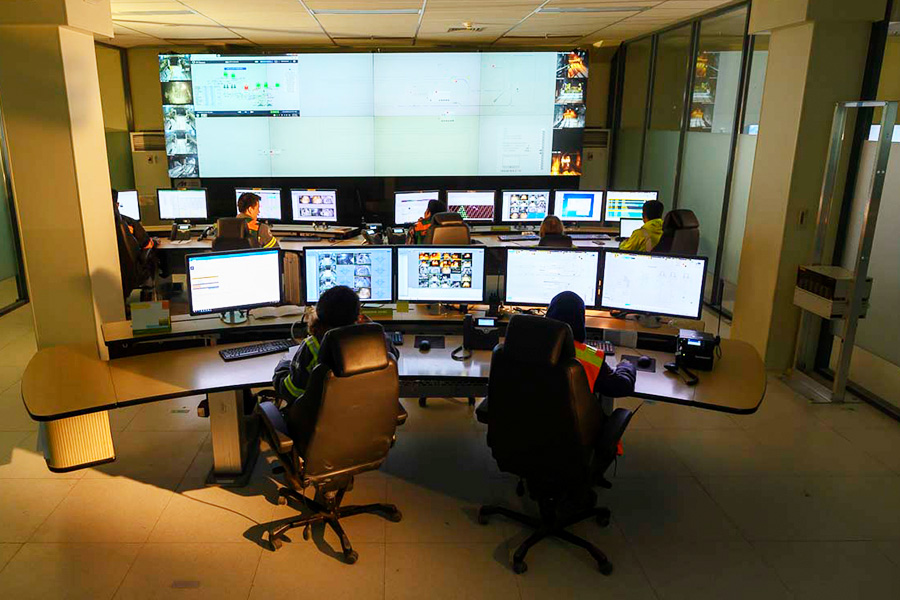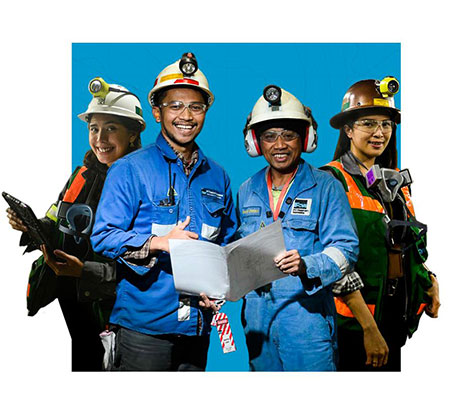13 July 2022

Mining is one of the occupations on earth with the highest risk level. Nevertheless, mining continues because the materials extracted from the bowels of the earth are a vital necessity for human lives.
For instance, copper mined by PT Freeport Indonesia (PTFI) in Tembagapura, Mimika, Papua is often called the metal of the future. Renewable energy development, solar power plants, and electric vehicles all need copper.
However, mining that is safe and without incident remains a goal to be realized.
Over the last few years alone, Kompas files recorded several incidents. For one, on Wednesday, 29 September 2021, 39 nickel mine workers in Ontario, Canada were able to be freed after being trapped for two days. A series of stairs was provided to evacuate the miners from a depth of around 1.2 kilometers.
On Sunday, 24 January 2021, 11 gold mine workers in Hushan, Qixia, Shandong Province in eastern China were trapped for 14 days. In September 2020, more than 160 jade miners died in a mine collapse in Hpakant, Myanmar.
In Indonesia, mining incidents are not non-existent. For instance, on Tuesday, 26 February 2019, tens of miners were buried under debris in a gold mining pit in the village of Desa Bakan, in Lolayan, Bolaang Mongondow, North Sulawesi. At the end of the search and rescue operation, 18 of the miners were able to be evacuated, while 28 others died.
These incidents are grim reminders of the risks inherent in mining. The risk is magnified when mining is not conducted in an open pit. PTFI, which currently runs the world’s biggest underground mining operation has now adopted state-of-the-art technology. Not to mention, this technology maximizes productivity.
Technology innovation
Over approximately the past decade, PTFI has been forging ahead to pioneer a mining technology innovation that has culminated in the use of remote mining in its underground operation. This includes unmanned electric railcars, unmanned ore loaders, and operations controlled remotely on ground surface.
Aprilia Ayomi (25) deftly moves her two hands. With both hands she pushes levers forward and then pulls them back. A moment later she shifts the levers left and right. As she continues to manipulate the two levers located on a level with her knees while she sits, her eyes are locked on the monitors before her.
Lia, as the woman born in Serui Regency, Papua is familiarly known by, sits demurely in a two-storey building while handling levers and buttons. As she works, she is guided by four monitors. Two front monitors directly facing her at eye level are spaced at a distance of around 1.5 meters from where she sits.
Another monitor, still facing her, is placed around 50 centimeters from where she sits, but is lower than the other two. Still another monitor is positioned to the left of her seat.
The four monitors have different functions. The two front eye-level monitors reveal the actual condition of the heavy equipment Lia operates. This heavy equipment operates in the Grasberg Block Cave underground mine located around 7 kilometers from where Lia sits.
The monitor facing Lia that is closer and lower than the two other front monitors reveal the condition of the tunnel, in moving yellow graphics. Meanwhile the touch-screen monitor to her left displays features with which to begin working and select from the range of heavy equipment available.
Assisted by the four monitors and the control equipment, Lia excavates material from the underground mine. This material is then transported and fed into a chute for further processing in the tunnel beneath. The material is in the form of chunks of greyish rock containing copper, silver, and gold.
I move mine material 150 times every day. But this could be less if there are problems with the system, the accounting graduate from Gadjah Mada University, Yogyakarta disclosed. Lia began working in February 2021. She is now one of tens of operators working remotely.
In addition to controlling excavation of material from a control room on the second floor of a building situated at Mile Point (MP) 72 Tembagapura, workers operate rock breakers and a railway transporting mining material. They hit buttons and manipulate levers while keeping their eyes fixed on monitors to ensure the heavy equipment move as commanded.
Workers Safety
Freeport Indonesia currently operates three underground mines, namely Deep Mill Level Zone (DMLZ), Grasberg Block Cave (GBC), and Big Gossan. The three underground mines are located 1,200 – 1,500 meters from the Grasberg open pit, renowned for its benches spiralling downward conically.
The Grasberg pit ended production in 2019, and PTFI is now focused on its three underground mines. For the operators, working remotely in an indoor space offers and ensures better safety and comfort. There is barely any risk involved, Yosias Pekei (29) who formerly operated heavy equipment in the tunnels, asserted.
The risk potential in operating an underground mine is no minor matter. Common occurrences are tunnel collapses, exposure to toxic gases, and fires. These incidents could lead to miners being injured and even losing their lives, and this had previously occurred at PTFI.
Given these risks, PTFI Senior Vice President of Underground Mines Hengky Rumbino says, the company now operates heavy equipment from a safe location. The primary and main consideration in investing in remote production operation is workers safety, the man born in Wamena, Jayawijaya Regency, Papua avers.
Hengky says underground mines have flashpoints, primarily with wet muck flows from drawpoints to loading. If manual work is involved, mine workers are faced with this hazard, on top of which production is hampered.
PTFI’s trial use of remote technology was imitated in the Deep Ore Zone area. At the time, the heavy equipment known as loaders continued to be operated in underground tunnels, albeit from a distance of 100 meters. Development continued until the most recent technology was achieved.
In the remote operation of heavy equipment, PTFI uses fiber optic grids. The grids connect the heavy equipment and railcars to a central control area on the surface. The communication system is provided by Midroc, a Swedish company that implements remote technology in the Kiruna underground mine in Sweden.
To date, application of remote operation of heavy equipment and mine material haulers is still meeting production expectations. For instance, loader productivity per hour is 270 tons of mine material, differing not far from the manual operation figure of 280 tons per hour.
PTFI’s underground mines currently produce 5.52 million tons of ore per month or 183,000 tons of ore per day. The biggest production is from GBC, which produces 3 million tons of ore per month.
One of the constraints currently faced is the frequent loss of connectivity with control equipment. When Kompas was present at the control room on Tuesday, 31 May 2022, a loader operation console known as minegem experienced loss of control. Operators had to move to another console pending repairs made to the system.
With an operation permit effective until 2041, and possibly extending beyond that date, we will surely witness even more technology innovations at PTFI’s underground mines. As mining operations evolve to become more massive with higher risks entailed, we are certainly open to technology development, PTFI Chief Mine Engineer Carl Tauran says.
As of 2018, 51.2 percent of PTFI shares now belong to the Indonesian government. Collaboration opportunity is wide open between PTFI and other state-owned companies, in particular those engaged in technology. With support from Telkom, PTFI is now set to become the first mining company in Southeast Asia to apply 5G internet technology in its operations.
A 5G internet grid will push the creation of even more innovative and reliable technologies. In the mining sector, operations will be rendered safer as productivity increases, enabling maximization of benefits from mineral products for the people’s prosperity.
Kami menghimbau para pencari kerja untuk berhati-hati dan mewaspadai beragam modus penipuan perekrutan yang mengatasnamakan PT Freeport Indonesia. Dalam setiap proses rekrutmen dan penerimaan karyawan, PT Freeport Indonesia maupun konsultan rekruitmennya tidak memungut biaya apapun.
Untuk melihat lowongan, silakan akses melalui link berikut: ptfi e-recruitment
Untuk melihat informasi magang, silakan akses melalui link berikut: Internship Program
